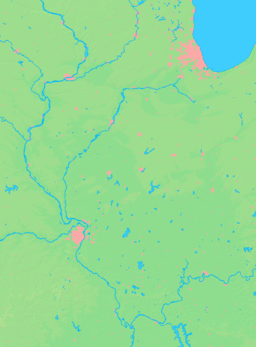Sparta, Illinois
| Sparta | |
| City | |
| Country | United States |
|---|---|
| State | Illinois |
| County | Randolph |
| Coordinates | 38°8′N 89°42′W / 38.133°N 89.700°WCoordinates: 38°8′N 89°42′W / 38.133°N 89.700°W |
| Area | 11.45 sq mi (30 km2) |
| - land | 11.17 sq mi (29 km2) |
| - water | 0.27 sq mi (1 km2) |
| Population | 4,302 (2010) |
| Density | 376/sq mi (145/km2) |
| Date | 1829 |
| Government | Mayor-council |
| Mayor | Jason Schlimme [1] |
| Timezone | CST (UTC-6) |
| - summer (DST) | CDT (UTC-5) |
| Postal code | 62286 |
| Area code | 618 |
  Location of Sparta within Illinois | |
| Wikimedia Commons: Sparta, Illinois | |
_2012-07-20.jpg)
Sparta is a city in Randolph County, Illinois, United States. The population was 4,302 at the 2010 census.[2]
The city was the principal filming location for the 1967 film In the Heat of the Night.[3]
Geography
Sparta is located at 38°8′N 89°42′W / 38.133°N 89.700°W (38.1282, -89.7061).[4]
According to the 2010 census, Sparta has a total area of 11.443 square miles (29.64 km2), of which 11.17 square miles (28.93 km2) (or 97.61%) is land and 0.273 square miles (0.71 km2) (or 2.39%) is water.[5]
Printing industry
After World War II, Sparta became known as "Magazineland, U.S.A." due to the presence of numerous printing plants that produced most of the mass-market color comic books in the United States. Spartan Printing employed as many as 1,000 people at its peak. Later, major comics distributors situated their warehouses in and around Sparta.[6]
World Shooting and Recreational Complex
In 2005, the Amateur Trapshooting Association (ATA) voted to move its headquarters from Vandalia, Ohio, to Sparta. The city and state governments had lobbied hard for the move to Sparta, which was necessitated by the expansion of the Dayton International Airport in Vandalia.
In 2006, then Illinois Governor Rod Blagojevich and local dignitaries opened the World Shooting and Recreational Complex north of Sparta. The ATA hosted its first Grand American at the facility in August, with several thousand shooters attending.
In 2012 the ATA moved their national headquarters to 1105 East Broadway, Sparta Illinois. All day-to-day operations for the Association are now handled at this location.
Demographics
| Historical population | |||
|---|---|---|---|
| Census | Pop. | %± | |
| 1870 | 1,335 | — | |
| 1880 | 1,754 | 31.4% | |
| 1890 | 1,979 | 12.8% | |
| 1900 | 2,941 | 48.6% | |
| 1910 | 3,081 | 4.8% | |
| 1920 | 3,340 | 8.4% | |
| 1930 | 3,385 | 1.3% | |
| 1940 | 3,664 | 8.2% | |
| 1950 | 3,576 | −2.4% | |
| 1960 | 3,452 | −3.5% | |
| 1970 | 4,307 | 24.8% | |
| 1980 | 4,957 | 15.1% | |
| 1990 | 4,853 | −2.1% | |
| 2000 | 4,486 | −7.6% | |
| 2010 | 4,302 | −4.1% | |
| Est. 2015 | 4,419 | [7] | 2.7% |
As of the census[9] of 2000, there were 4,486 people, 1,783 households, and 1,164 families residing in the city. The population density was 496.6 people per square mile (191.8/km²). There were 2,014 housing units at an average density of 223.0 per square mile (86.1/km²). The racial makeup of the city was 81.39% White, 15.65% African American, 0.36% Native American, 0.51% Asian, 0.27% from other races, and 1.83% from two or more races. Hispanic or Latino of any race were 1.36% of the population.
There were 1,783 households out of which 30.8% had children under the age of 18 living with them, 47.9% were married couples living together, 13.8% had a female householder with no husband present, and 34.7% were non-families. 30.0% of all households were made up of individuals and 14.4% had someone living alone who was 65 years of age or older. The average household size was 2.42 and the average family size was 3.01.
In the city the population was spread out with 25.6% under the age of 18, 8.0% from 18 to 24, 24.8% from 25 to 44, 23.0% from 45 to 64, and 18.6% who were 65 years of age or older. The median age was 39 years. For every 100 females there were 83.4 males. For every 100 females age 18 and over, there were 79.4 males.
The median income for a household in the city was $34,139, and the median income for a family was $41,908. Males had a median income of $30,386 versus $19,819 for females. The per capita income for the city was $16,343. About 10.9% of families and 16.0% of the population were below the poverty line, including 27.3% of those under age 18 and 4.2% of those age 65 or over.
Notable persons
- Earle Gardner, infielder for the New York Highlanders
- John Wittenborn, kicker for San Francisco 49ers, Philadelphia Eagles, and Houston Oilers
- Darius Jackson, running back for the Dallas Cowboys
References
- ↑ http://spartaillinois.us/city-government.html
- ↑ "Profile of General Population and Housing Characteristics: 2010 Demographic Profile Data (DP-1): Sparta city, Illinois". U.S. Census Bureau, American Factfinder. Retrieved January 3, 2012.
- ↑ The American Film Institute Catalog of Motion Pictures Produced in the United States: Feature Films, 1961-1970, Part 2. American Film Institute. 1997. p. 530.
- ↑ "US Gazetteer files: 2010, 2000, and 1990". United States Census Bureau. 2011-02-12. Retrieved 2011-04-23.
- ↑ "G001 - Geographic Identifiers - 2010 Census Summary File 1". United States Census Bureau. Retrieved 2015-12-27.
- ↑ http://www.icv2.com/articles/news/695.html
- ↑ "Annual Estimates of the Resident Population for Incorporated Places: April 1, 2010 to July 1, 2015". Retrieved July 2, 2016.
- ↑ "Census of Population and Housing". Census.gov. Retrieved June 4, 2015.
- ↑ "American FactFinder". United States Census Bureau. Retrieved 2008-01-31.
External links
- City of Sparta official website
- Randolph County Herald Tribune
- World Shooting and Recreational Complex